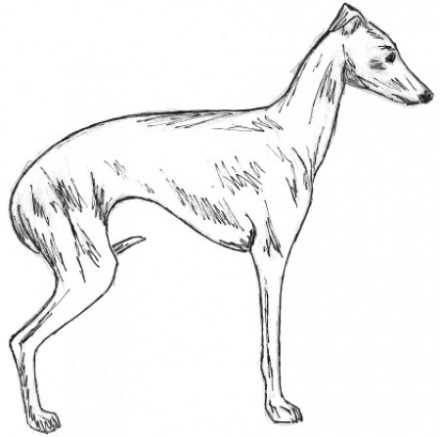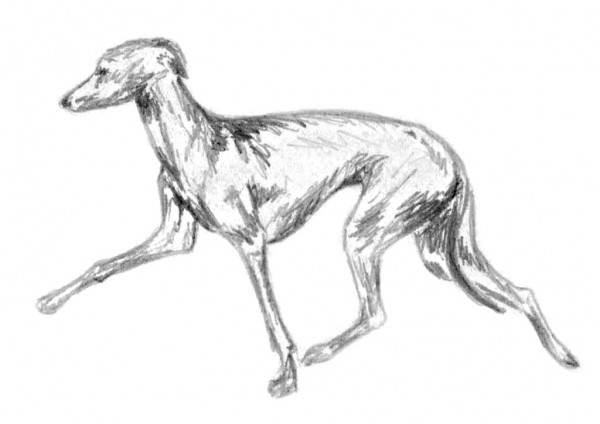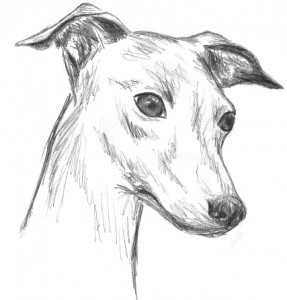05.01.2011/EN
FCI-Standard N°200
ITALIAN GREYHOUND
(Piccolo Levriero Italiano)
TRANSLATION: Mrs. Peggy Davis. Revised by ENCI and Renée Sporre-Willes / Original version : (FR).
The original is available on the FCI website.

ORIGIN: Italy.
DATE OF PUBLICATION OF THE OFFICIAL VALID STANDARD: 13.10.2010.
UTILIZATION: Racing dog.
FCI-CLASSIFICATION: Group 10 Sighthounds.
Section 3 Short-haired sighthounds
Without working trial.
BRIEF HISTORICAL SUMMARY: The little Italian Greyhound descends from small-sized sighthounds which already existed in ancient Egypt at the court of the Pharaohs. Passing through Laconie (Greece), where numerous representations on vases and bowls confirm this, the breed arrived in Italy at the outset of the 5th century BC. Its greatest development occurred during the era of the Renaissance at the court of the nobles. It is not rare to find the Italian Greyhound represented in the paintings of the greatest Italian and foreign masters
GENERAL APPEARANCE: Of slender appearance, its body fits into a square. Although of a small size, it fully characterises a miniature sighthound; the prototype of refinement and elegance. May be considered as a model of grace and distinction.
IMPORTANT PROPORTIONS: Its length is equal to or only just inferior to the height at the withers. Length of skull is equal to half the length of the head. Length of head can reach 40% of the height at the withers.
BEHAVIOUR AND TEMPERAMENT: Lively, affectionate, docile.
HEAD Of elongated shape and narrow.
CRANIAL REGION:
Skull: Flat with the superior axes of the skull and muzzle parallel. Length of the skull is equal to half the length of the head, which has slightly rounded sides. Lower orbital region well chiselled. Muscles of the head must not show any heavy appearance. Marked eyebrow bones. Not prominent occiput. Only slightly marked median depression.
Stop: Frontal nasal depression only very slightly marked.
FACIAL REGION:
Nose: Of a dark colour, preferably black with well opened nostrils.
Muzzle: Tapered.
Lips: Thin and tight, with edges of lips very darkly pigmented.
Jaws / Teeth: Jaws elongated with well aligned incisors crown shape, strong in relation to size of dog. Teeth sound and complete, set square to the jaws; scissor bite.
Cheeks: Lean.
Eyes: Large, roundish, and expressive, sub-frontally positioned, neither deep-set nor protruding. Iris of dark colour, eyerims pigmented.
Ears: Set very high, small, with fine cartilage, folded in itself and carried well back on the nape and upper part of the neck. When the dog is attentive, the base of the ear is erected and the lobe tends to stand out laterally on the horizontal, position commonly known as “flying ears” or “propeller ears”.
NECK: The nape is slightly arched and broken at its base towards the withers. The throat line is slightly convex. Neck length equal to that of the head. Shaped like a truncated cone, well muscled. Skin lean without dewlap.
BODY: Its length is equal to, or barely inferior to the height at the withers.
Topline: Straight profile with slightly arched dorsal-lumbar region. The lumbar curve merging harmoniously into the line of the rump.
Withers: Quite well defined with closely placed top of shoulders.
Back: Straight, well muscled.
Croup: Very sloping, wide and muscled.
Chest: Narrow, solid but elegantly modelled with slight spring of ribs. Deep, let down to the elbows.
Underline and belly: The rather short sternal arch is accentuated and rises without abruptness to the belly.
TAIL: Low set, fine even at base, tapering progressively to its tip. It is carried low and straight in its first half, the 2nd half curved. Stretched it should reach the top of the hock. Covered with short hair.
LIMBS
FOREQUARTERS:
General appearance: On the whole straight and vertical with lean muscles.
Shoulder: Very slightly sloping with well developed, long lean and salient muscles.
Upper arm: With a very open scapular-humeral angle parallel to the median plane of the body. The upper arm is slightly longer than the shoulderblade.
Elbow: Neither out nor tied-in at elbows.
Forearm: Straight. Refined bone structure, flat and lean; in perfect vertical position as much from the front as in profile. Well evident furrow from the carpus to the elbow. Length from ground to elbow, just slightly more than the length from elbow to the withers.
Metacarpus (Pastern): Dry. Seen in profile it is slightly bent.
Forefeet: Of almost oval shape, small, with arched and closely knit toes. Not voluminous pads, pigmented. Nails black or dark according to coat colour or that of the feet, where white is tolerated.
HINDQUARTERS:
General appearance: Well angulated. Seen from behind on the whole straight and parallel.
Thigh: Long, lean, not voluminous, with very distinct muscles.
Lower thigh: Very sloping, with refined bone structure and well apparent groove in leg muscle. They are a little longer than upper thighs.
Metatarsus (Rear pastern): Seen from behind, must be parallel.
Hindfeet: Less oval than the forefeet, with arched and closely knit toes; not voluminous pads and nails pigmented like forefeet.
GAIT / MOVEMENT: Springy, harmonious, slightly raised trot, covering the ground. This means that the front legs must be moved forward with good reach and with slightly lifted and bent pasterns. Gallop fast with sharp spring.

SKIN: Fine and tight on all parts of the body except for the elbows where it is slightly less tight.
COAT
Hair: The hair is short, silky and fine all over the body without the slightest trace of fringes.
Colour: Self-coloured in black, grey, and isabella (pale yellowish/beige) in all possible shades. White is tolerated only on the chest and feet.
SIZE AND WEIGHT:
Height at the withers: Males and females from 32 to 38 cms.
Weight: Males and females: maximum 5 kgs.
FAULTS:
Any departure from the foregoing points should be considered a fault and the seriousness with which the fault should be regarded should be in exact proportion to its degree and its effect upon the health and welfare of the dog.
• Continuous ambling.
• Hackney movement.
• Movement close to the ground with short steps.
DISQUALIFYING FAULTS
• Aggressive or overly shy.
• Any dog clearly showing physical or behavioural abnormalities shall be disqualified.
• Accentuated convergence or divergence of the facial-cranial axes.
• Nose totally or half de-pigmented.
• Nasal bridge concave or convex.
• Overshot or undershot bite.
• Wall eye; total de-pigmentation of eyerims.
• Tail carried over the back; anury or short tail, whether congenital
or artificial.
• Dewclaws.
• Multicoloured coat; white except in chest and feet as mentioned
above.
• Size below 32 cms or over 38 cms, as well in males as in females.
ELIMINATING FAULTS: (Excluded from breeding)
• Overshot bite.
• Chryptorchidism; unilateral
N.B. : Male animals should have two apparently normal testicles fully descended into the scrotum.
The latest amendments are in bold characters.

____________________________________________________________________________________________________________________
The Italian Greyhound ilustrated standard by Mrs. Lilian Barber a Mrs. Angela Leonard (corresponding to the American Breed Standard).
FCI Standard in Italian (ENCI)


